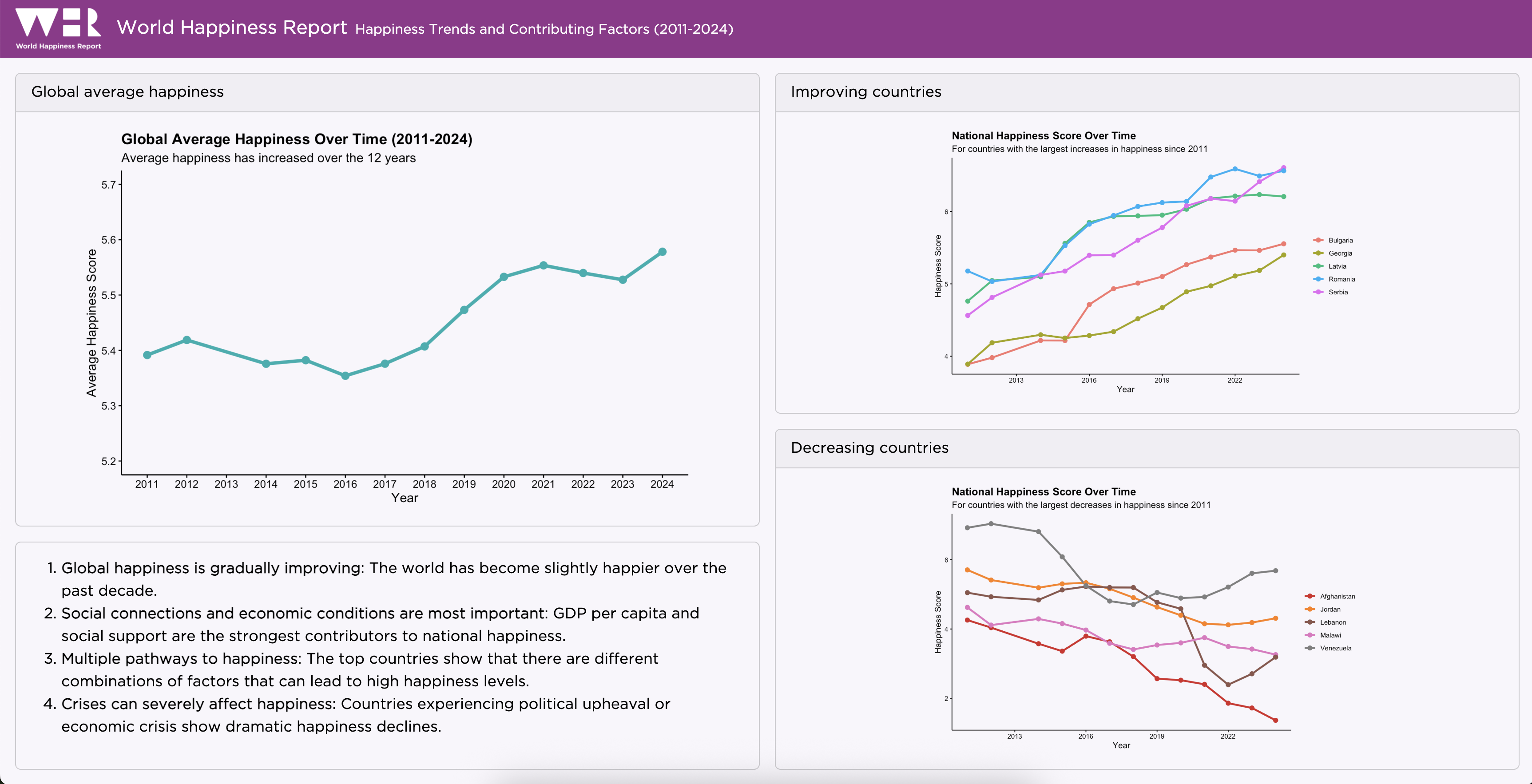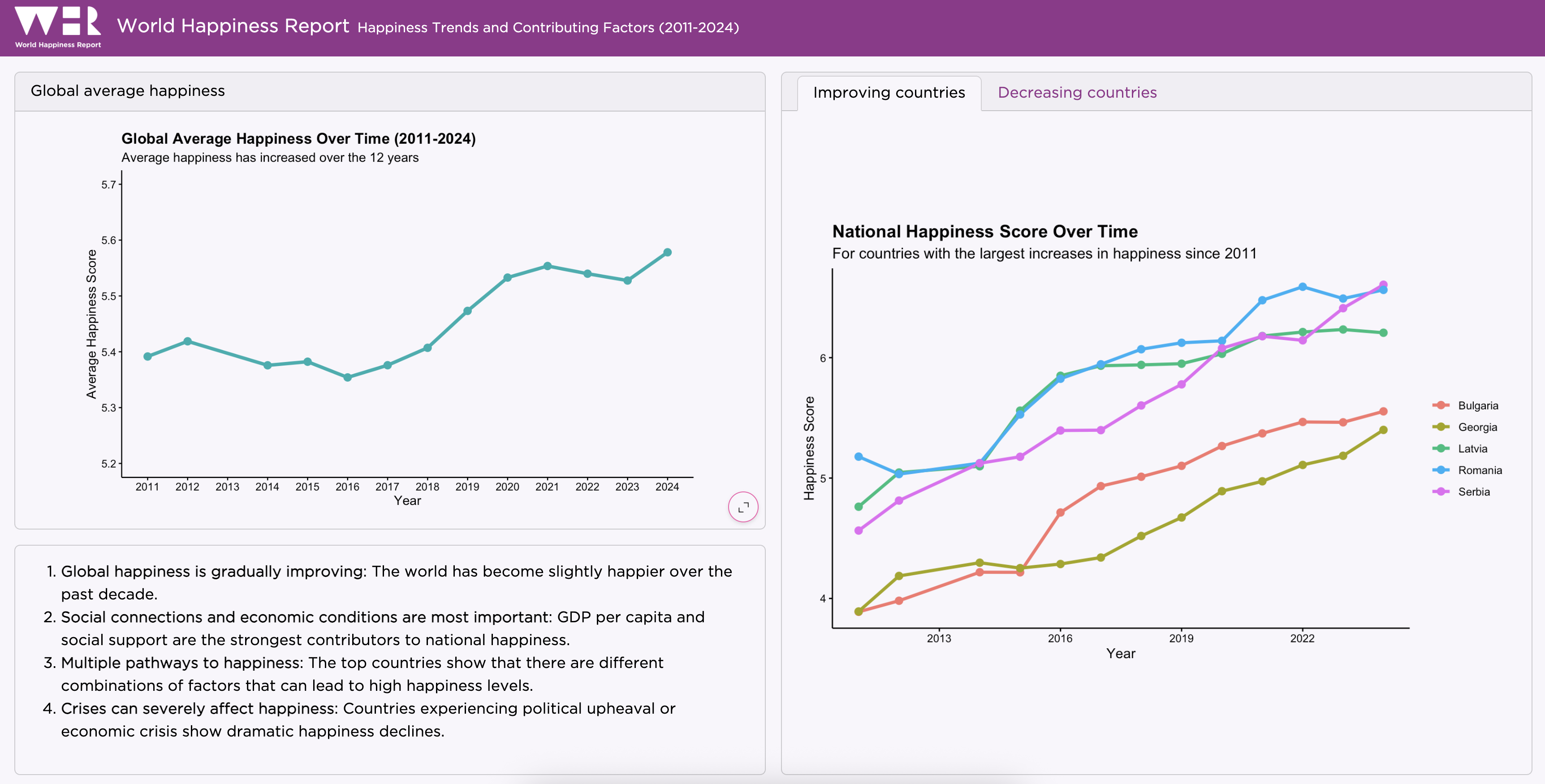03:00
Quarto
Dashboards
Hello, Dashboards!
Hello, Dashboards!
Dashboard basics
First dashboard
Layout
Dashboard components
Quarto ➝ many outputs
With Quarto you can weave together narrative text and code to produce elegantly formatted output as documents, web pages, blog posts, books, and more…
Quarto ➝ dashboards




🌎 World Happiness Report dashboard

Notebook ➝ Dashboard
Dashboard basics
Hello, Dashboards!
Dashboard basics
First dashboard
Layout
Dashboard components
Cards
Dashboards are composed of cards.
Rows and columns
Cards are arranged into rows and columns.
Layouts
Pages, tabsets, and sidebars allow for more advanced layouts.
Step-by-step
Let’s make a dashboard, step-by-step
First dashboard
Hello, Dashboards!
Dashboard basics
First dashboard
Layout
Dashboard components
Step 1: format: dashboard
Step 2: Add a card
Step 2: Add a card
Step 3: Add another card
dashboard.qmd
Step 3: Add another card
dashboard.qmd

Step 4: Add titles to cards
dashboard.qmd
---
title: "My first Quarto dashboard"
format: dashboard
---
```{python}
from plotnine import ggplot, aes, geom_point, geom_bar
from plotnine.data import mpg
```
```{python}
#| title: Highway vs. city mileage
(
ggplot(mpg, aes(x = "cty", y = "hwy"))
+ geom_point()
)
```
```{python}
#| title: Drive types
(
ggplot(mpg, aes(x = "drv"))
+ geom_bar()
)
```Step 4: Add titles to cards
dashboard.qmd
---
title: "My first Quarto dashboard"
format: dashboard
---
```{python}
from plotnine import ggplot, aes, geom_point, geom_bar
from plotnine.data import mpg
```
```{python}
#| title: Highway vs. city mileage
(
ggplot(mpg, aes(x = "cty", y = "hwy"))
+ geom_point()
)
```
```{python}
#| title: Drive types
(
ggplot(mpg, aes(x = "drv"))
+ geom_bar()
)
```
Steps 1 - 4

brand.yml works with dashboards too!

Your turn
- Open
dashboard-r.qmdordashboard-python.qmd. - Change the format from
htmltodashboard. - Re-render.
- Add relevant titles to each card.
The brand.yml file should be automatically applied!
Layout
Hello, Dashboards!
Dashboard basics
First dashboard
Layout
Dashboard components
Rows
By default, cards are laid out in rows:
dashboard.qmd
---
title: "Rows"
format: dashboard
---
```{python}
from plotnine import ggplot, aes, geom_point, geom_bar
from plotnine.data import mpg
```
## Scatter
```{python}
#| title: Highway vs. city mileage
(
ggplot(mpg, aes(x = "cty", y = "hwy"))
+ geom_point()
)
```
## Bar
```{python}
#| title: Drive types
(
ggplot(mpg, aes(x = "drv"))
+ geom_bar()
)
```Rows
dashboard.qmd
---
title: "Rows"
format: dashboard
---
```{python}
from plotnine import ggplot, aes, geom_point, geom_bar
from plotnine.data import mpg
```
## Scatter
```{python}
#| title: Highway vs. city mileage
(
ggplot(mpg, aes(x = "cty", y = "hwy"))
+ geom_point()
)
```
## Bar
```{python}
#| title: Drive types
(
ggplot(mpg, aes(x = "drv"))
+ geom_bar()
)
```
Rows
Default value of orientation is rows:
dashboard.qmd
---
title: "Rows"
format:
dashboard:
orientation: rows
---
```{python}
from plotnine import ggplot, aes, geom_point, geom_bar
from plotnine.data import mpg
```
## Scatter
```{python}
#| title: Highway vs. city mileage
(
ggplot(mpg, aes(x = "cty", y = "hwy"))
+ geom_point()
)
```
## Bar
```{python}
#| title: Drive types
(
ggplot(mpg, aes(x = "drv"))
+ geom_bar()
)
```Columns
Setting orientation to columns makes each ## indicate a column instead of a row:
dashboard.qmd
---
title: "Columns"
format:
dashboard:
orientation: columns
---
```{python}
from plotnine import ggplot, aes, geom_point, geom_bar
from plotnine.data import mpg
```
## Scatter
```{python}
#| title: Highway vs. city mileage
(
ggplot(mpg, aes(x = "cty", y = "hwy"))
+ geom_point()
)
```
## Bar
```{python}
#| title: Drive types
(
ggplot(mpg, aes(x = "drv"))
+ geom_bar()
)
```Columns
dashboard.qmd
---
title: "Columns"
format:
dashboard:
orientation: columns
---
```{python}
from plotnine import ggplot, aes, geom_point, geom_bar
from plotnine.data import mpg
```
## Scatter
```{python}
#| title: Highway vs. city mileage
(
ggplot(mpg, aes(x = "cty", y = "hwy"))
+ geom_point()
)
```
## Bar
```{python}
#| title: Drive types
(
ggplot(mpg, aes(x = "drv"))
+ geom_bar()
)
```
Rows, then columns
dashboard.qmd
---
title: "Rows, then columns"
format: dashboard
---
```{python}
from plotnine import ggplot, aes, geom_point, geom_bar
from plotnine.data import mpg
```
## Overview
###
This dashboard summarizes an illuminating analysis of fuel economy of cars.
###
This is a car.
{fig-alt="Illustration of a teal color car."}
## Plots
### Scatter
```{python}
#| title: Highway vs. city mileage
(
ggplot(mpg, aes(x = "cty", y = "hwy"))
+ geom_point()
)
```
### Bar
```{python}
#| title: Drive types
(
ggplot(mpg, aes(x = "drv"))
+ geom_bar()
)
```Rows, then columns
dashboard.qmd
---
title: "Rows, then columns"
format: dashboard
---
```{python}
from plotnine import ggplot, aes, geom_point, geom_bar
from plotnine.data import mpg
```
## Overview
###
This dashboard summarizes an illuminating analysis of fuel economy of cars.
###
This is a car.
{fig-alt="Illustration of a teal color car."}
## Plots
### Scatter
```{python}
#| title: Highway vs. city mileage
(
ggplot(mpg, aes(x = "cty", y = "hwy"))
+ geom_point()
)
```
### Bar
```{python}
#| title: Drive types
(
ggplot(mpg, aes(x = "drv"))
+ geom_bar()
)
```
Columns, then rows
dashboard.qmd
---
title: "Rows, then columns"
format:
dashboard:
orientation: columns
---
```{python}
from plotnine import ggplot, aes, geom_point, geom_bar
from plotnine.data import mpg
```
## Overview
###
This dashboard summarizes an illuminating analysis of fuel economy of cars.
###
This is a car.
{fig-alt="Illustration of a teal color car."}
## Plots
### Scatter
```{python}
#| title: Highway vs. city mileage
(
ggplot(mpg, aes(x = "cty", y = "hwy"))
+ geom_point()
)
```
### Bar
```{python}
#| title: Drive types
(
ggplot(mpg, aes(x = "drv"))
+ geom_bar()
)
```Columns, then rows
dashboard.qmd
---
title: "Rows, then columns"
format:
dashboard:
orientation: columns
---
```{python}
from plotnine import ggplot, aes, geom_point, geom_bar
from plotnine.data import mpg
```
## Overview
###
This dashboard summarizes an illuminating analysis of fuel economy of cars.
###
This is a car.
{fig-alt="Illustration of a teal color car."}
## Plots
### Scatter
```{python}
#| title: Highway vs. city mileage
(
ggplot(mpg, aes(x = "cty", y = "hwy"))
+ geom_point()
)
```
### Bar
```{python}
#| title: Drive types
(
ggplot(mpg, aes(x = "drv"))
+ geom_bar()
)
```
Your turn
Change the layout of your dashboard so that it looks like this:

05:00
Dashboard components
Hello, Dashboards!
Dashboard basics
First dashboard
Layout
Dashboard components
Quarto dashboards are highly customizable!
Navigation bar and pages
Icon, title, and author along with links to sub-pages if more than one page is defined.

Sidebars, rows, columns, and tabsets
Rows and columns using markdown headings, with optional attributes to control height, width, etc. Sidebars, mostly used for for interactive inputs. Tabsets to further divide content.

Cards
Cards are containers for code cell outputs (e.g., plots, tables, value boxes) and free form markdown text. The content of cards typically maps to cells in your notebook or source document.

Your turn
Take a look at the Tabsets documentation on the Quarto website.
Move the plots showing the countries that increased and decreased in happiness into a tabset. Your dashboard should then look like this:

05:00
Tabsets
dashboard.qmd
---
title: "Tabsets"
format: dashboard
---
```{python}
from plotnine import ggplot, aes, geom_point, geom_bar
from plotnine.data import mpg
```
## Overview {.tabset}
### Objective
This dashboard summarizes an illuminating analysis of fuel economy of cars.
### Car
This is a car.
{fig-alt="Illustration of a teal color car." width="299"}
## Plots {.tabset}
### Scatter
```{python}
#| title: Highway vs. city mileage
(
ggplot(mpg, aes(x = "cty", y = "hwy"))
+ geom_point()
)
```
### Bar
```{python}
#| title: Drive types
(
ggplot(mpg, aes(x = "drv"))
+ geom_bar()
)
```Tabsets
Each card within a row/column or each row/column within another becomes a tab:
dashboard.qmd
---
title: "Tabsets"
format: dashboard
---
```{python}
from plotnine import ggplot, aes, geom_point, geom_bar
from plotnine.data import mpg
```
## Overview {.tabset}
### Objective
This dashboard summarizes an illuminating analysis of fuel economy of cars.
### Car
This is a car.
{fig-alt="Illustration of a teal color car." width="299"}
## Plots {.tabset}
### Scatter
```{python}
#| title: Highway vs. city mileage
(
ggplot(mpg, aes(x = "cty", y = "hwy"))
+ geom_point()
)
```
### Bar
```{python}
#| title: Drive types
(
ggplot(mpg, aes(x = "drv"))
+ geom_bar()
)
```
Pages
dashboard.qmd
---
title: "Pages"
format: dashboard
---
```{python}
from plotnine import ggplot, aes, geom_point, geom_bar
from plotnine.data import mpg
```
# Scatter
```{python}
#| title: Highway vs. city mileage
(
ggplot(mpg, aes(x = "cty", y = "hwy"))
+ geom_point()
)
```
# Bar
```{python}
#| title: Drive types
(
ggplot(mpg, aes(x = "drv"))
+ geom_bar()
)
```Pages
dashboard.qmd
---
title: "Pages"
format: dashboard
---
```{python}
from plotnine import ggplot, aes, geom_point, geom_bar
from plotnine.data import mpg
```
# Scatter
```{python}
#| title: Highway vs. city mileage
(
ggplot(mpg, aes(x = "cty", y = "hwy"))
+ geom_point()
)
```
# Bar
```{python}
#| title: Drive types
(
ggplot(mpg, aes(x = "drv"))
+ geom_bar()
)
```
Pages
dashboard.qmd
---
title: "Pages"
format: dashboard
---
```{python}
from plotnine import ggplot, aes, geom_point, geom_bar
from plotnine.data import mpg
```
# Scatter
```{python}
#| title: Highway vs. city mileage
(
ggplot(mpg, aes(x = "cty", y = "hwy"))
+ geom_point()
)
```
# Bar
```{python}
#| title: Drive types
(
ggplot(mpg, aes(x = "drv"))
+ geom_bar()
)
```
Navigation buttons
dashboard.qmd
---
title: "Navigation buttons"
format:
dashboard:
nav-buttons:
- icon: github
href: https://github.com/quarto-dev/quarto-cli
aria-label: GitHub
- icon: linkedin
href: https://www.linkedin.com/company/posit-software/
aria-label: LinkedIn
- icon: youtube
href: https://youtube.com/
aria-label: YouTube
---
```{python}
from plotnine import ggplot, aes, geom_point, geom_bar
from plotnine.data import mpg
```
# Scatter
```{python}
#| title: Highway vs. city mileage
(
ggplot(mpg, aes(x = "cty", y = "hwy"))
+ geom_point()
)
```
# Bar
```{python}
#| title: Drive types
(
ggplot(mpg, aes(x = "drv"))
+ geom_bar()
)
```Navigation buttons
dashboard.qmd
---
title: "Navigation buttons"
format:
dashboard:
nav-buttons:
- icon: github
href: https://github.com/quarto-dev/quarto-cli
aria-label: GitHub
- icon: linkedin
href: https://www.linkedin.com/company/posit-software/
aria-label: LinkedIn
- icon: youtube
href: https://youtube.com/
aria-label: YouTube
---
```{python}
from plotnine import ggplot, aes, geom_point, geom_bar
from plotnine.data import mpg
```
# Scatter
```{python}
#| title: Highway vs. city mileage
(
ggplot(mpg, aes(x = "cty", y = "hwy"))
+ geom_point()
)
```
# Bar
```{python}
#| title: Drive types
(
ggplot(mpg, aes(x = "drv"))
+ geom_bar()
)
```
Value boxes
Value boxes are a great way to prominently display simple values within a dashboard
You can create value boxes in executable cells or plain markdown in divs
Value boxes use Bootstrap icons (https://icons.getbootstrap.com) and can be set to any color (e.g., with a HEX code) or color alias defined by the theme.
Color alias Default theme color(s) primaryBlue secondaryGray successGreen infoBright Blue warningYellow/Orange dangerRed lightLight Gray darkBlack
Value boxes
dashboard.qmd
---
title: "Valueboxes"
format: dashboard
---
```{python}
from plotnine import ggplot, aes, geom_point, geom_bar
from plotnine.data import mpg
```
## Value boxes {height="25%"}
```{python}
#| label: calculate-values
lowest_mileage_index = mpg['cty'].idxmin()
lowest_mileage_car = mpg.iloc[lowest_mileage_index]
lowest_mileage_cty = mpg.loc[lowest_mileage_index, 'cty']
highest_mileage_index = mpg['cty'].idxmax()
highest_mileage_car = mpg.iloc[highest_mileage_index]
highest_mileage_cty = mpg.loc[highest_mileage_index, 'cty']
mean_city_mileage = mpg['cty'].mean()
rounded_mean_city_mileage = round(mean_city_mileage, 2)
```
```{python}
#| content: valuebox
#| title: "Least efficient"
#| icon: fuel-pump-fill
#| color: danger
dict(
value = str(f"{lowest_mileage_cty} mpg")
)
```
```{python}
#| content: valuebox
#| title: "Most efficient"
dict(
icon = "fuel-pump",
color = "success",
value = str(f"{highest_mileage_cty} mpg")
)
```
::: {.valuebox icon="fuel-pump" color="secondary"}
Average city mileage
`{python} str(rounded_mean_city_mileage)` mpg
:::
## Plots {height="75%"}
```{python}
#| title: Highway vs. city mileage
(
ggplot(mpg, aes(x = "cty", y = "hwy"))
+ geom_point()
)
```
```{python}
#| title: Drive types
(
ggplot(mpg, aes(x = "drv"))
+ geom_bar()
)
```Value boxes
dashboard.qmd
---
title: "Valueboxes"
format: dashboard
---
```{python}
from plotnine import ggplot, aes, geom_point, geom_bar
from plotnine.data import mpg
```
## Value boxes {height="25%"}
```{python}
#| label: calculate-values
lowest_mileage_index = mpg['cty'].idxmin()
lowest_mileage_car = mpg.iloc[lowest_mileage_index]
lowest_mileage_cty = mpg.loc[lowest_mileage_index, 'cty']
highest_mileage_index = mpg['cty'].idxmax()
highest_mileage_car = mpg.iloc[highest_mileage_index]
highest_mileage_cty = mpg.loc[highest_mileage_index, 'cty']
mean_city_mileage = mpg['cty'].mean()
rounded_mean_city_mileage = round(mean_city_mileage, 2)
```
```{python}
#| content: valuebox
#| title: "Least efficient"
#| icon: fuel-pump-fill
#| color: danger
dict(
value = str(f"{lowest_mileage_cty} mpg")
)
```
```{python}
#| content: valuebox
#| title: "Most efficient"
dict(
icon = "fuel-pump",
color = "success",
value = str(f"{highest_mileage_cty} mpg")
)
```
::: {.valuebox icon="fuel-pump" color="secondary"}
Average city mileage
`{python} str(rounded_mean_city_mileage)` mpg
:::
## Plots {height="75%"}
```{python}
#| title: Highway vs. city mileage
(
ggplot(mpg, aes(x = "cty", y = "hwy"))
+ geom_point()
)
```
```{python}
#| title: Drive types
(
ggplot(mpg, aes(x = "drv"))
+ geom_bar()
)
```
Value boxes - R syntax
dashboard.qmd
---
title: "Valueboxes"
format: dashboard
---
```{r}
#| content: valuebox
#| title: "Least efficient"
#| icon: fuel-pump-fill
#| color: danger
list(
value = paste(lowest_mileage_cty, "mpg")
)
```
```{r}
#| content: valuebox
#| title: "Most efficient"
list(
icon = "fuel-pump",
color = "success",
value = paste(highest_mileage_cty, "mpg")
)
```
::: {.valuebox icon="fuel-pump" color="secondary"}
Average city mileage
30 mpg
:::Markdown text
You can include markdown text anywhere within a dashboard
Markdown text is automatically placed in cards, but you can also explicitly put them in cards with fenced divs, and add titles to cards
You can place markdown text and other cell output in a single card as well
Your turn
Add two value boxes to your dashboard, above the tabset, so that your dashboard looks like this:

Use the brand colors. You can either hard-code the value box values (“Finland” and “Social support”) or calculate them using the data.
05:00
…and much more!
There’s much more you can adjust and do with Quarto dashboards, including:
- Specify additional layout options, like scrolling
- Use dynamic cell titles
- Add a sidebar

